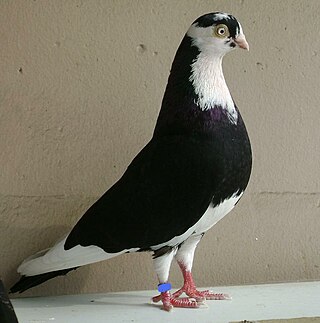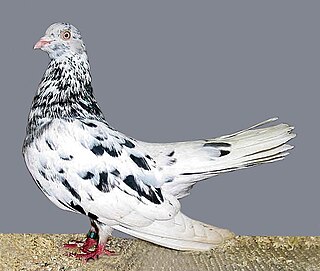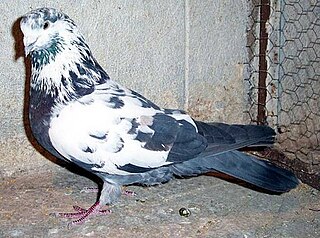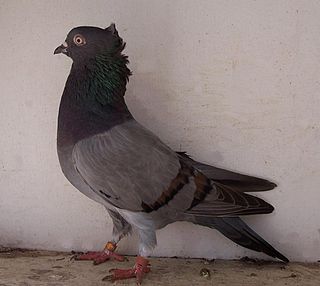There are at least four main types of competitive pigeon sport:

Aerobatic maneuvers are flight paths putting aircraft in unusual attitudes, in air shows, dogfights or competition aerobatics. Aerobatics can be performed by a single aircraft or in formation with several others. Nearly all aircraft are capable of performing aerobatics maneuvers of some kind, although it may not be legal or safe to do so in certain aircraft.
Fancy pigeon refers to any breed of domestic pigeon, which is a domesticated form of the wild rock dove. They are bred by pigeon fanciers for various traits relating to size, shape, color, and behavior, and often exhibited at pigeon shows, fairs and other livestock exhibits.
The tippler is a breed of domestic pigeon bred to participate in endurance competitions. Flying results of up to 22 hours (non-stop) have been reported.

The blue-gray mottle-headed pigeon is a breed of domestic pigeon, blue-gray to blue in color but with a patterned white head, found principally in the Ural region of Russia.

Pigeon keeping or pigeon fancying is the art and science of breeding domestic pigeons. People have practiced pigeon keeping for at least 5,000 years and in almost every part of the world. In that time, humans have substantially altered the morphology and the behaviour of the domesticated descendants of the rock dove to suit their needs for food, aesthetic satisfaction and entertainment.

Eejanaika (ええじゃないか) is a steel 4th Dimension Hypercoaster at Fuji-Q Highland in Fujiyoshida, Yamanashi, Japan. The ride was the world's second 4th Dimension coaster. Eejanaika is taller, faster, and longer than its predecessor, X2 at Six Flags Magic Mountain.

The Galatz Roller or Galați Roller is a domesticated pigeon breed originating in Galați County, Romania. Because these pigeons perform air acrobatics when they fly, they became very popular among pigeon fanciers in both the country of origin and the rest of Europe, especially in Germany, the Netherlands and Belgium. The air acrobatics that these Galați Roller birds perform are comparable to those of the Oriental Roller and Birmingham Roller pigeons.

The Komorn Tumbler is a breed of fancy pigeon developed over many years of selective breeding. The breed has American and European varieties that are recognized as separate breeds at shows with classes catering for American Komorner Tumblers and European Komorner Tumblers. Originally bred for acrobatic flying as a tumbler pigeon, Komorners are seldom free-flown today, and exist only for exhibition in pigeon shows.

A roller pigeon is a domesticated breed or variety of pigeon that has been selected for its ability to tumble or roll in the air. Varieties of roller pigeons include:

The Australian Performing Tumbler (APT) is a breed of fancy pigeon.

The Oriental Roller is a breed of fancy pigeon developed over many years of selective breeding. Oriental Rollers, along with all other varieties of domesticated pigeons, are descended from the rock pigeon.

Tumbler pigeons are varieties of domesticated pigeons that are descendants of the rock dove that have been selected for their ability to tumble or roll over backwards in flight.

The Iranian Highflying Tumbler pigeon also known as "Persian Highflying Tumbler" in Europe and "Tehrani" in Iran is a breed of domestic pigeon bred in Iran for performance and endurance flying competitions. They fly at a very high altitude and at times out of sight. The tumbling is nothing like a Birmingham Roller, individual flips, occasionally hovering before it does the flip.

The Parlor Roller is a breed of domesticated pigeon developed over many years of selective breeding. Parlor Rollers, along with other varieties of domesticated pigeons, are all descendants from the rock pigeon. The breed is known for its unique performance of turning somersaults on the ground. Parlor Rollers are considered to be further development from the Parlor Tumbler.
This is a general glossary of the terms used in the sport of gymnastics.

The Serbian Highflyer is a breed of domestic pigeon that is bred for endurance flying. The breed is characterized by long circle flights up to 15 hours. It can fly as high as 1,500 metres (4,900 ft). There are about 20,000 fanciers of this breed in Serbia.
The Vienna Long-faced Tumbler is one of numerous breeds of tumbler pigeons, reared and exhibited for their ability to spin and tumble down suddenly whilst in flight. Originating in Austria, in and around Vienna, it is an old breed that was known there in the 17th century. It was introduced by the Turks and was crossed with the Barb. It was exhibited in Hamburg in 1867. Dürien (1886) described nine color varieties. In Germany this breed is considered a "medium-faced" one, but in the United States it is considered "long-faced." It mostly occurs in large cities within the United States, since it is usually brought to this country by immigrants.













